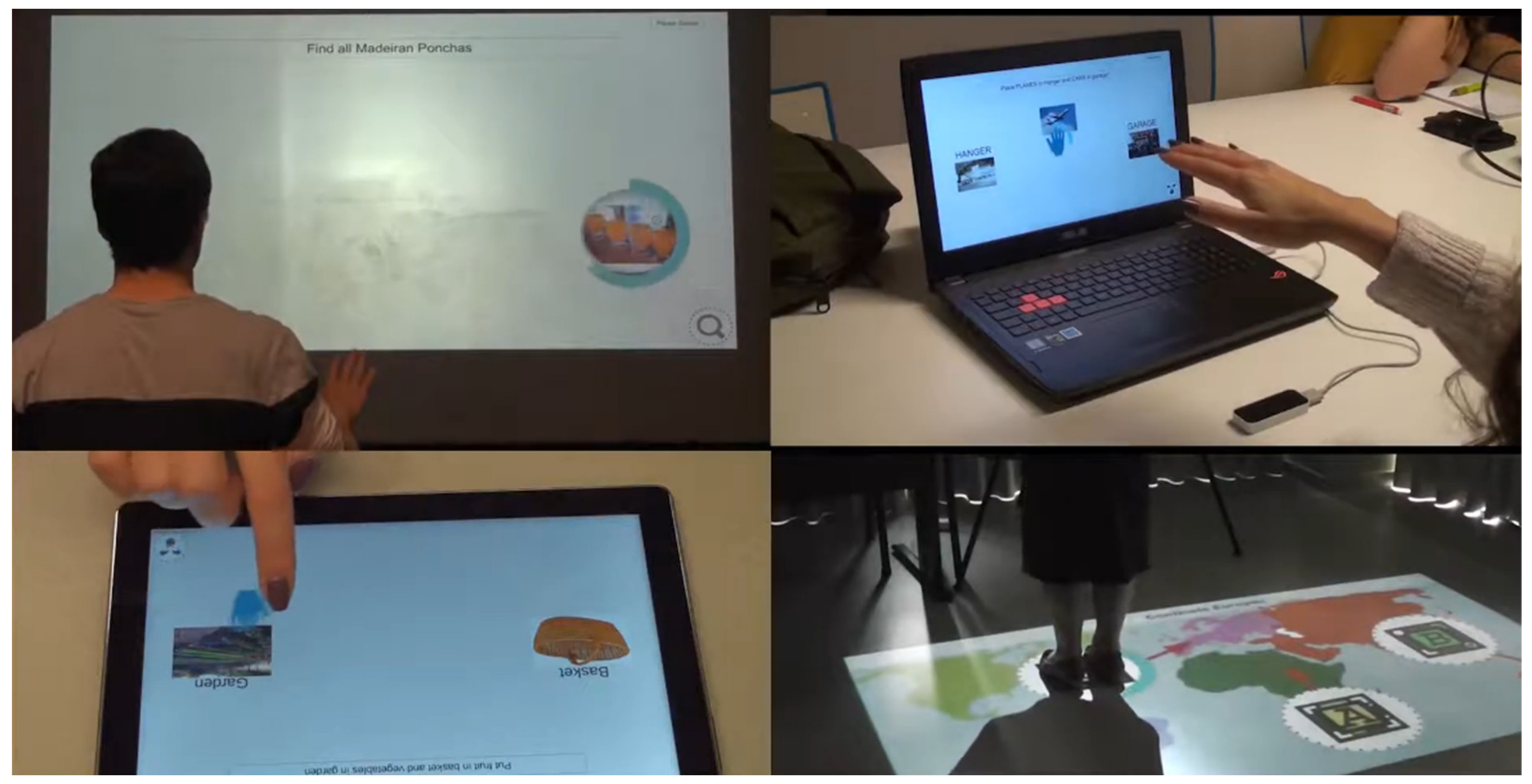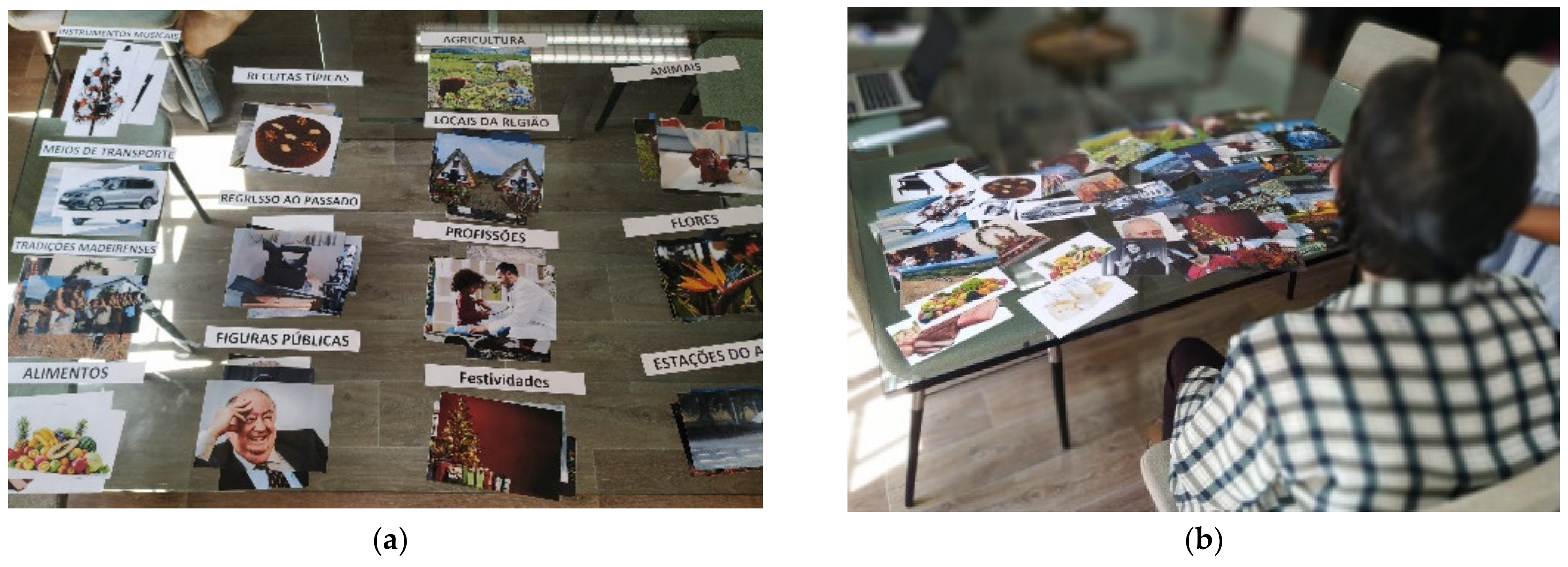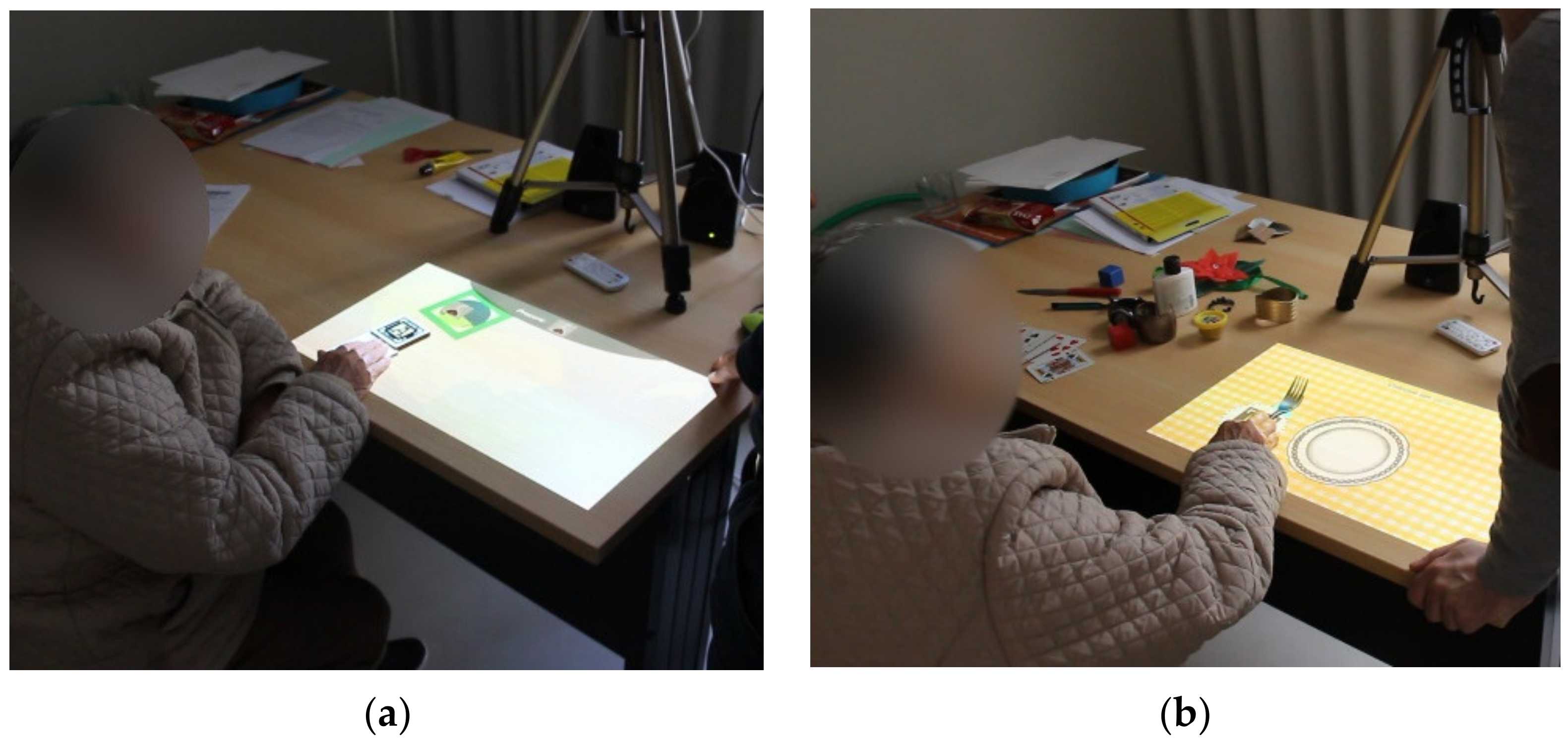Customizing a Cognitive Stimulation Program for Individuals with Dementia through a Participatory Design Approach
Abstract
:1. Introduction
1.1. The Burden of Dementia and Non-Pharmacological Approaches as a Research Priority
- IwD can benefit from cognitive stimulation if we mobilize relatively preserved cognitive functions (e.g., crystallized abilities such as semantic memory and verbal skills);
1.2. Interactive Technologies as a Valuable Tool to Implement Non-Pharmacological Approaches
- Reality Orientation—a quiz-like activity that includes date and time information.
- Creative Drawings—a puzzle-like game in which missing parts must be drawn using real paper and crayons.
- Activities of Daily Living (ADL)—a puzzle-like game in which real physical objects (e.g., toothpaste) must be used to answer.
- Search Objects—an exploration game where hidden images (e.g., cats) must be found using a magnifying glass.
- Knowledge Quiz—a quiz-like activity in which the correct answer must be selected.
- Association—a categorizing activity where items must be organized according to the instructions (e.g., separate cars from motorcycles).
1.3. Designing Interactive Technologies-Based CCSP’s for IwD
1.4. Aims of the Study
- RQ1: How can a participatory strategy be implemented to create content for a CCSP involving both IwD and formal caregivers?
- RQ2: Which guidelines should formal caregivers consider to engage IwD in the customization of CCSP?
2. Materials and Methods
2.1. Participants
2.2. Procedure
- (1)
- Interviews with formal caregivers
- (2)
- Interviews with IwD
- (3)
- Development of the activities
2.3. Tools
- Formal caregivers, in what concerns the development and implementation of cognitive stimulation activities of IwD (e.g., difficulties experienced);
- IwD when performing the implemented task (e.g., comments and feelings);
- The researcher, when implementing the task with IwD.
3. Results
3.1. Interviews with Formal Caregivers and IwD
3.2. Guidelines
- Communicating with IwD;
- Music content selection;
- Reminiscence content selection.
4. Discussion
- 1.
- Communicating with patients
- 2.
- Music content selection
- 3.
- Reminiscence content selection
5. Conclusions
Author Contributions
Funding
Institutional Review Board Statement
Informed Consent Statement
Data Availability Statement
Conflicts of Interest
References
- Mental Health of Older Adults. Available online: https://www.who.int/news-room/fact-sheets/detail/mental-health-of-older-adults (accessed on 9 November 2022).
- Dementia. Available online: https://www.who.int/news-room/fact-sheets/detail/dementia (accessed on 9 November 2022).
- National Collaborating Centre for Mental Health; Britain, G. Dementia: The NICE-SCIE Guideline on Supporting People with Dementia and Their Carers in Health and Social Care; British Psychological Society and Royal College of Psychiatrists: London, UK, 2007. [Google Scholar]
- Ravdin, L.D.; Katzen, H.L. Handbook on the Neuropsychology of Aging and Dementia; Springer: Berlin/Heidelberg, Germany, 2013. [Google Scholar]
- Woods, B. Dementia Care: Progress and Prospects. J. Ment. Health 1995, 4, 115–124. [Google Scholar] [CrossRef]
- Spector, A.; Woods, B.; Orrell, M. Cognitive Stimulation for the Treatment of Alzheimer’s Disease. Expert Rev. Neurother. 2008, 8, 751–757. [Google Scholar] [CrossRef] [PubMed]
- Bahar-Fuchs, A.; Clare, L.; Woods, B. Cognitive Training and Cognitive Rehabilitation for Mild to Moderate Alzheimer’s Disease and Vascular Dementia. Cochrane Database Syst. Rev. 2013, 6, 1–73. [Google Scholar] [CrossRef] [Green Version]
- Woods, B.; Aguirre, E.; Spector, A.E.; Orrell, M. Cognitive Stimulation to Improve Cognitive Functioning in People with Dementia. Cochrane Database Syst. Rev. 2012, 2, 1–56. [Google Scholar] [CrossRef] [PubMed]
- Aguirre, E.; Hoare, Z.; Streater, A.; Spector, A.; Woods, B.; Hoe, J.; Orrell, M. Cognitive Stimulation Therapy (CST) for People with Dementia—Who Benefits Most? Int. J. Geriatr. Psychiatry 2013, 28, 284–290. [Google Scholar] [CrossRef] [PubMed]
- Spector, A.; Orrell, M.; Davies, S.; Woods, B. Can Reality Orientation Be Rehabilitated? Development and Piloting of an Evidence-Based Programme of Cognition-Based Therapies for People with Dementia. Neuropsychol. Rehabil. 2001, 11, 377–397. [Google Scholar] [CrossRef]
- Spector, A.; Thorgrimsen, L.; Woods, B.O.B.; Royan, L.; Davies, S.; Butterworth, M.; Orrell, M. Efficacy of an Evidence-Based Cognitive Stimulation Therapy Programme for People with Dementia: Randomised Controlled Trial. Br. J. Psychiatry 2003, 183, 248–254. [Google Scholar] [CrossRef]
- Hall, L.; Orrell, M.; Stott, J.; Spector, A. Cognitive Stimulation Therapy (CST): Neuropsychological Mechanisms of Change. Int. Psychogeriatr. 2013, 25, 479–489. [Google Scholar] [CrossRef] [Green Version]
- Krell-Roesch, J.; Syrjanen, J.A.; Vassilaki, M.; Machulda, M.M.; Mielke, M.M.; Knopman, D.S.; Kremers, W.K.; Petersen, R.C.; Geda, Y.E. Quantity and Quality of Mental Activities and the Risk of Incident Mild Cognitive Impairment. Neurology 2019, 93, e548–e558. [Google Scholar] [CrossRef] [Green Version]
- Baird, A.; Samson, S. Memory for Music in Alzheimer’s Disease: Unforgettable? Neuropsychol. Rev. 2009, 19, 85–101. [Google Scholar] [CrossRef]
- Huber, A.; Oppikofer, S.; Meister, L.; Langensteiner, F.; Meier, N.; Seifert, A. Music & Memory: The Impact of Individualized Music Listening on Depression, Agitation, and Positive Emotions in Persons with Dementia. Act. Adapt. Aging 2021, 45, 70–84. [Google Scholar]
- Van der Steen, J.T.; Smaling, H.J.; Van der Wouden, J.C.; Bruinsma, M.S.; Scholten, R.J.; Vink, A.C. Music-Based Therapeutic Interventions for People with Dementia. Cochrane Database Syst. Rev. 2018, 7, 1–99. [Google Scholar] [CrossRef] [PubMed] [Green Version]
- Ferreira, L.D.A.; Cavaco, S.; Badia, S.B.i. Musiquence: A Framework to Customize Music and Reminiscence Cognitive Stimulation Activities for the Dementia Population. In Proceedings of the 2019 5th Experiment International Conference (exp. at’19), Funchal, Portugal, 12–14 June 2019; IEEE: Piscataway, NJ, USA, 2019; pp. 359–364. [Google Scholar]
- Marin, A.G.; Seiciu, P.L.; Popescu, A.M.; Bighea, A.; Berteanu, M. Technology for Post-Stroke Cognitive Rehabilitation. Int. J. Pharma Med. Biol. Sci. 2015, 4, 146. [Google Scholar]
- Ferreira, L.D.A.; Ferreira, H.; Cavaco, S.; Cameirão, M.; Badia, S.B.i. User Experience of Interactive Technologies for People with Dementia: Comparative Observational Study. JMIR Serious Games 2020, 8, e17565. [Google Scholar] [CrossRef]
- Span, M.; Hettinga, M.; Groen-van de Ven, L.; Jukema, J.; Janssen, R.; Vernooij-Dassen, M.; Eefsting, J.; Smits, C. Involving People with Dementia in Developing an Interactive Web Tool for Shared Decision-Making: Experiences with a Participatory Design Approach. Disabil. Rehabil. 2018, 40, 1410–1420. [Google Scholar] [CrossRef]
- Tanner, D. Co-Research with Older People with Dementia: Experience and Reflections. J. Ment. Health 2012, 21, 296–306. [Google Scholar] [CrossRef]
- Félix, S.B.; Ribeiro, O.; Maia, H. Personalized Cognitive Stimulation through Personhood: A Case Report on Dementia Diagnosis Acceptance and Therapeutic Engagement. Clin. Gerontol. 2020, 43, 233–239. [Google Scholar] [CrossRef]
- Suijkerbuijk, S.; Nap, H.H.; Cornelisse, L.; IJsselsteijn, W.A.; De Kort, Y.A.; Minkman, M. Active Involvement of People with Dementia: A Systematic Review of Studies Developing Supportive Technologies. J. Alzheimer’s Dis. 2019, 69, 1041–1065. [Google Scholar] [CrossRef] [Green Version]
- Hendriks, N.; Truyen, F.; Duval, E. Designing with Dementia: Guidelines for Participatory Design Together with Persons with Dementia. In Proceedings of the IFIP Conference on Human-Computer Interaction, Cape Town, South Africa, 2–6 September 2013; Springer: Berlin/Heidelberg, Germany, 2013; pp. 649–666. [Google Scholar]
- Lindsay, S.; Brittain, K.; Jackson, D.; Ladha, C.; Ladha, K.; Olivier, P. Empathy, Participatory Design and People with Dementia. In Proceedings of the SIGCHI Conference on Human Factors in Computing Systems, Austin, TX, USA, 5–10 May 2012; pp. 521–530. [Google Scholar]
- Hendriks, N.; Huybrechts, L.; Wilkinson, A.; Slegers, K. Challenges in Doing Participatory Design with People with Dementia. In Proceedings of the 13th Participatory Design Conference: Short Papers, Industry Cases, Workshop Descriptions, Doctoral Consortium Papers, and Keynote Abstracts-Volume 2, Windhoek, Namibia, 6–10 October 2014; pp. 33–36. [Google Scholar]
- Wang, G.; Marradi, C.; Albayrak, A.; van der Cammen, T.J. Co-Designing with People with Dementia: A Scoping Review of Involving People with Dementia in Design Research. Maturitas 2019, 127, 55–63. [Google Scholar] [CrossRef] [Green Version]
- Johannessen, A.; Engedal, K.; Haugen, P.K.; Dourado, M.C.N.; Thorsen, K. “To Be, or Not to Be”: Experiencing Deterioration among People with Young-Onset Dementia Living Alone. Int. J. Qual. Stud. Health Well-Being 2018, 13, 1490620. [Google Scholar] [CrossRef] [Green Version]
- Grobosch, S.; Wolf, F.; Juchems, S.; Kuske, S. Emotional Safety of People Living with Dementia: A Systematic Review. J. Ment. Health 2020, 1–22. [Google Scholar] [CrossRef] [PubMed]
- Spector, A.; Orrell, M.; Woods, B. Cognitive Stimulation Therapy (CST): Effects on Different Areas of Cognitive Function for People with Dementia. Int. J. Geriatr. Psychiatry 2010, 25, 1253–1258. [Google Scholar] [CrossRef] [PubMed]
- Folstein, M.F.; Folstein, S.E.; McHugh, P.R. “Mini-Mental State”: A Practical Method for Grading the Cognitive State of Patients for the Clinician. J. Psychiatr. Res. 1975, 12, 189–198. [Google Scholar] [CrossRef]
- Andrade Ferreira, L.D.; Cavaco, S.; Bermúdez i Badia, S. Feasibility Study of an Augmented Reality System for People with Dementia; The Eurographics Association: Eindhoven, The Netherlands, 2018; pp. 141–148. [Google Scholar] [CrossRef]
- Ferreira, L.; Cavaco, S.; Badia, S.B.I. A Usability Study with Healthcare Professionals of a Customizable Framework for Reminiscence and Music Based Cognitive Activities for People with Dementia. In Proceedings of the 23rd Pan-Hellenic Conference on Informatics, Nicosia, Cyprus, 28–30 November 2019; pp. 16–23. [Google Scholar]





| Groups | Inclusion Criteria |
|---|---|
| Formal caregivers |
|
| IwD |
|
| Sample Groups | Topics Approached |
|---|---|
| Formal Caregivers |
|
| IwD |
|
| Cycles | Sessions | Theme | Song |
|---|---|---|---|
| 1 | 1 and 2 | Public Figures | A Mula da Cooperativa |
| 2 | 3 and 4 | Festivities | Laurindinha |
| 3 | 5 and 6 | Regional Traditions | Ó Rosa arredonda a saia |
| 4 | 7 and 8 | Flowers | Nem às paredes confesso |
| 5 | 9 and 10 | Agriculture | Playback |
| 6 | 11 and 12 | Regional Recipes | Aldeia da Roupa Branca |
| 7 | 13 and 14 | Foods | Olhos Castanhos |
Publisher’s Note: MDPI stays neutral with regard to jurisdictional claims in published maps and institutional affiliations. |
© 2022 by the authors. Licensee MDPI, Basel, Switzerland. This article is an open access article distributed under the terms and conditions of the Creative Commons Attribution (CC BY) license (https://creativecommons.org/licenses/by/4.0/).
Share and Cite
Spínola, M.; Câmara, J.; Ferreira, L.; Faria, A.L.; Badia, S.B.i. Customizing a Cognitive Stimulation Program for Individuals with Dementia through a Participatory Design Approach. Appl. Sci. 2022, 12, 11612. https://doi.org/10.3390/app122211612
Spínola M, Câmara J, Ferreira L, Faria AL, Badia SBi. Customizing a Cognitive Stimulation Program for Individuals with Dementia through a Participatory Design Approach. Applied Sciences. 2022; 12(22):11612. https://doi.org/10.3390/app122211612
Chicago/Turabian StyleSpínola, Mónica, Joana Câmara, Luís Ferreira, Ana Lúcia Faria, and Sergi Bermúdez i Badia. 2022. "Customizing a Cognitive Stimulation Program for Individuals with Dementia through a Participatory Design Approach" Applied Sciences 12, no. 22: 11612. https://doi.org/10.3390/app122211612





